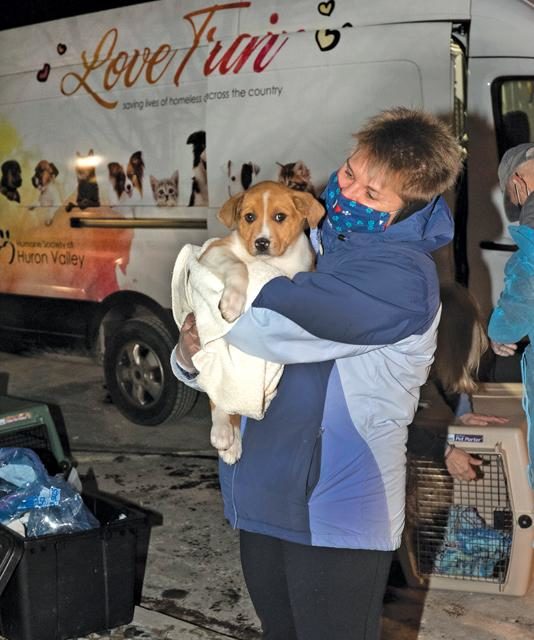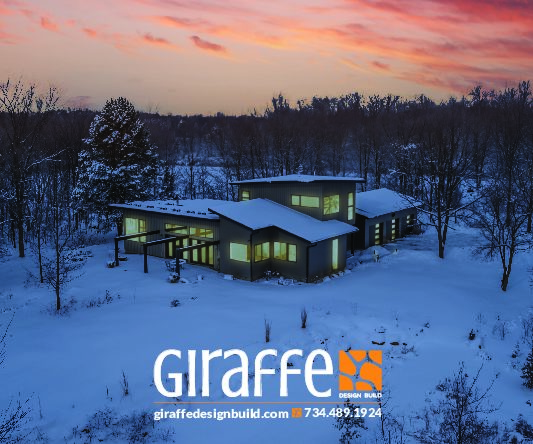Jeff Mortimer had no idea it would be so hard to adopt a cat.
“My friend who is a volunteer at the humane society–a cat ‘comforter–was keeping her eye out for me,” says the veteran freelance writer. Not a young cat–“because of my age, I don’t want any cats outliving me”–and not a male cat–“I have two boys and they’re fine, [but] it’s a different kind of relationship.”
In December, his friend connected him with a thirteen-year-old cat named Carol. “We hit it off.” Mortimer says. “It seemed like she recognized me.”
But he couldn’t just take Carol home. “The snag was that when you bring a new cat into a household that already has a cat or cats, it’s a good idea to have them have a space of their own for a while,” Mortimer explains. The only available space was “a room that I’m embarrassed to say, especially on the record, hadn’t been cleaned for about ten years.”
The Humane Society of Huron Valley (HSHV) lets folks put a hold on potential pets for twenty-four hours, but Mortimer “knew the room wasn’t going to be clean in twenty-four hours.” So he bid Carol farewell on Friday and spent the weekend cleaning. “I probably should have called Sunday, but I didn’t in part because I foolishly thought there wasn’t going to be any big demand for a thirteen-year-old cat.”
First thing Monday morning Mortimer called and left a message. He got a call back that afternoon saying that Carol had already been adopted by someone else.
“I don’t blame them,” he adds quickly. “Their job is to get cats adopted.”
Three months later, Mortimer’s friend is still looking. Even elderly cats, she told him by email, “go so quickly I barely get to know them” before someone claims them.
—
During the pandemic, cats and dogs of every age are getting adopted at record rates. HSHV took in 6,000 cats and dogs in 2019, and 5,000 were adopted, emails executive director Tanya Hilgendorf. In 2020 they took in 5,500, with 4,700 adoptions.
“We had a slight reduction in animals coming into the shelter but also saw those animals adopted at a faster rate,” Hilgendorf writes. That meant they spent 25 percent fewer days in HSHV’s care, which “is fantastic for the overall welfare of our animals, reducing stress and sickness.” And between adoptions and lost pets reunited with their owners, HSHV’s already high save rate rose to 97 percent.
Hilgendorf attributes the interest to “people having more time to care for a companion animal [during the pandemic], and surely wanting the company and love of a good animal during a particularly stressful and lonely time.”
To date, HSHV has had just three Covid cases among its 107 employees, and a few mostly mild cases among the animals. Hilgendorf credits their 30,000-square-foot building, opened in 2009 at a cost of $8.6 million. “This facility was built to prevent the spread of contagious disease, including airborne disease,” she says. “We have an advanced HVAC system with frequent fresh air exchanges. We have UV light all through our entire building to kill viruses and bacteria that move through the air.”
Most programming is still suspended– the Tiny Lions lounge and adoption center is still taking a catnap–and there’s “a limit on how many people can come into the building.” And like everyone who deals with the public, they’ve had anti-‘maskers “coming here really just looking for a fight,” says Hilgendorf. They tried “reasoning with folks not in a confrontational way but in a compassionate way. When that didn’t work, we offered to set them up appointments when the building is closed to the public. If you don’t give somebody a fight, it kind of takes the wind out of their sail.”
But as it did for everyone, the pandemic forced HSHV to radically change how it does business. Governor Whitmer’s stay-home orders last spring shut down much of their public programming and the income it brought in. Hilgendorf had to furlough twenty-seven employees from late March through early June.
“We continued functioning all through the stay-home orders [because] our donors stood up and said, ‘We are going to be here with you,” says Hilgendorf, fighting back tears. While fee income shrank along with program capacity, fundraising is meeting goals. But when the intake of adoptable animals fell seasonally this winter, she again had to reduce the hours of about thirty employees at the end of February. Hilgendorf says the gap can be filled by additional unemployment benefits, and she anticipates that most if not all will be back to their regular hours by April.
—
The shortage of adoptable pets would be even more severe if not for the Love Train.
“I have to take responsibility for that name,” laughs ‘Hilgendorf–she borrowed it from the O’Jays’ 1972 hit. The Love Train’s ‘twenty-first-century iteration is a white Ford Transit van–adorned with pictures of adorable cats and dogs–that rescues unwanted animals from the southern U.S.
“Sterilization of dogs has really taken root in almost everywhere above the South,” Hilgendorf explains. “The Love Train allows us to go to Southern shelters where they would without us have to euthanize them.”
It shut down at the start of the pandemic but was back up and running within months.
“It was an incredible experience,” says Realtor Laurie Buys. An HSHV board member, she contributed $2,500 to sponsor that first post-shutdown trip in May, riding shotgun with driver Krista Byberg.
“It’s just the front two seats,” Buys explains, “and then behind you it’s all just crates lined up and then medical supplies. I brought snacks, water, [and] a tote bag because you’re just spending one night.”
They drove straight through to Hardin County, Tennessee, at the Alabama and Mississippi borders. The Hardin Animal Relocation and Transition Team is “run by Jenn and Billy Penick,” says Buys, “the kindest couple in the whole world, who sacrifice everything they have to make this happen.” The Penicks have two houses and a pole barn set on rolling acres, plus dozens of dogs and other animals.
“Everything is clean,” Buys says. “They’re well taken care of.” And she “got to go into the puppy room and fall in love with the puppies. Their breath is so sweet, and they’re just so cute!
“We took back twenty-three puppies the next day,” Buys says. “You start loading up each puppy into a crate, and you secure them, [and] you hit the road.” The Love Train stops only for gas and bathroom breaks–but not for the puppies. “You can’t let the animals out for their safety,” Buys explains. “They’re fine–they have big crates, they have puppy pads, they have blankets, they have water. They may whine and bark, and it’s stinky, but you don’t care.”
Though the Love Train brings up “roughly forty puppies every two weeks,” Hilgendorf says, “we have usually three times the number of people wanting puppies.” To prevent crowding, they set up an appointment-based adoption process, with folks arriving at the shelter at 7 a.m. to sign in at a kiosk and wait in their cars.
But then some began coming even earlier. In January, “folks started lining up at 10:30 p.m. the night before,” Hilgendorf emails. So they set up a mobile app that lets people sign up in a virtual line and track their place in line on their phones.
“The App company says they can handle the traffic,” she writes. “Hopefully they are prepared for the powerful force of the Love Train.”


